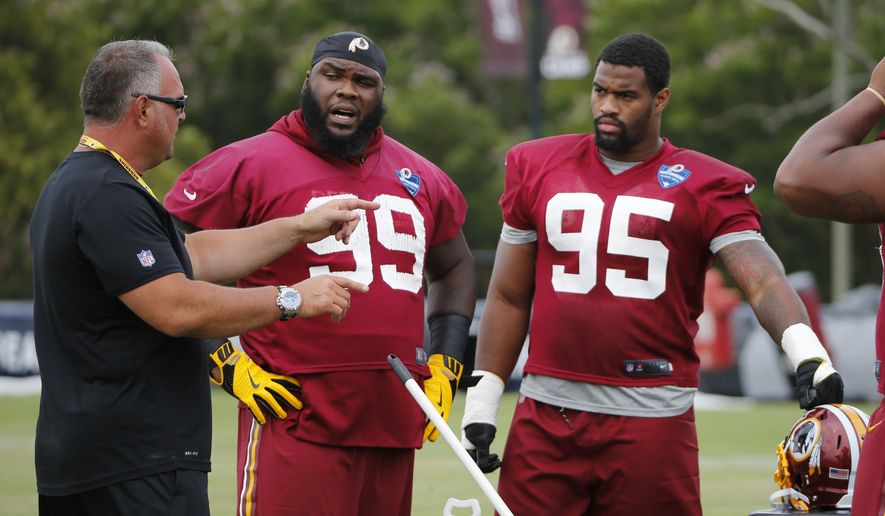All along, Redskins defensive coordinator Greg Manusky has told reporters his unit will make an impression this season.
“We might not win a game but we will really beat the crap out of a lot of people,” Manusky said in May.
Replacing the fired Joe Barry, Manusky was promoted to the coordinator’s job in January after spending 2016 as Washington’s linebackers coach.
Manusky, who’s been a defensive coordinator in San Francisco (2007-10), San Diego (2011) and Indianapolis (2012-15), has had varying degrees of success, but one thing is clear: Manusky has earned a reputation from his days as a player and his journey through coaching.
“Manusky is a student of the game,” linebacker Chris Carter said. “He’s played 12 years, which I think says a lot.”
Pressure, pressure, pressure
Carter has been a journeyman across the league playing for four teams in six seasons before joining the Redskins in the offseason. In 2014, Carter joined the Indianapolis Colts in September and was released a month later.
But in that time, he was able to learn the defense and recognize the similarities to what Manusky is trying to instill in Washington.
“That’s something you learn being around the league a lot,” Carter said. “When coaches travel, they take their defenses with them. It was very successful for him there. He’s bringing that here.”
With the Colts, Manusky blitzed — and then some.
In 2014, according to Pro Football Focus, the Colts blitzed 41.4 percent on all dropbacks, third highest in a league where the average team sent an extra defender 29.35 percent that season. The Colts’ rate was an improvement over the previous year, and Indianapolis’ second under Manusky, where they blitzed a ninth-best 33.3 percent of the time.
There’s a difference between blitzing and generating pressure, however. In Indianapolis, Manusky’s teams struggled, at times, in getting to the quarterback. For instance in 2014, the Colts, according to Football Outsiders, created pressure on only 22.7 percent of their plays. The average team that year got pressure 24.6 percent on dropbacks.
Manusky was fired after the 2015 season in part because of the defense’s lack of success while pressuring.
The Colts, who went 8-8 in 2015, generated a rush on 26.5 percent of their plays, but they ranked 20th in DVOA with pressure — which measures how efficient teams are against a league-average baseline.
In simpler words, Manusky’s defense was still giving up plays when getting to the quarterback. The 2015 Colts also only managed 22 sacks, down from 41 the year before.
By comparison, the Redskins ranked 12th in pressure (28.4 percent) and 16th in DVOA with pressure last year under Barry.
Carter said Manusky has tweaked Redskins blitzes to better suit Washington’s personnel.
“I think they’re a lot more effective and keep the offensives we’re going against on their toes a lot more,” he said. “They’re a lot harder to identify.”
Judging by performance
In San Francisco, it took a couple of seasons before Manusky’s system began to show results. The 49ers ranked 24th in defensive DVOA in 2007, but improved to 19th the following year. In 2009, the 49ers had a top-five defense, ranking fifth in defensive DVOA.
Redskins defensive end Stacy McGee said Manusky does a great job of taking advantage of players’ strengths. McGee, signed from the Oakland Raiders in the offseason, is learning the scheme for the first time.
With the Raiders, McGee played in an attacking front, where the defense in Washington reads blocks, then moves.
“Everybody fits well for each the positions they’re in,” McGee said. “It could lead up to a lot of success for us.”
Manusky said being with the Redskins for a year helped the transition.
One problem from last season he plans to address? Getting the most out of cornerback Josh Norman’s skillset.
Norman, who signed a five-year, $75 million deal last year, spent 49 percent of his snaps in man coverage in 2016 after playing zone 71 percent of his snaps in Carolina in 2015, according to Pro Football Focus.
“I am going to try to use his talents a little bit better, try to get him in quarters a little bit and get him in different coverages that we have,” Manusky said. “So we will get him to play the ball a little bit more.”
Getting the Redskins defense off the field is likely Manusky’s greatest challenge.
Opposing teams converted a league-high 46.6 percent of third downs last year against the Redskins.
Manusky has had a decent track record for getting stops on third down: 35.46 percent with the Colts in 2014, third-best in the league. In four years in Indianapolis, opposing teams converted more than 40 percent on third downs only once (2013).
• Matthew Paras can be reached at mparas@washingtontimes.com.




Please read our comment policy before commenting.